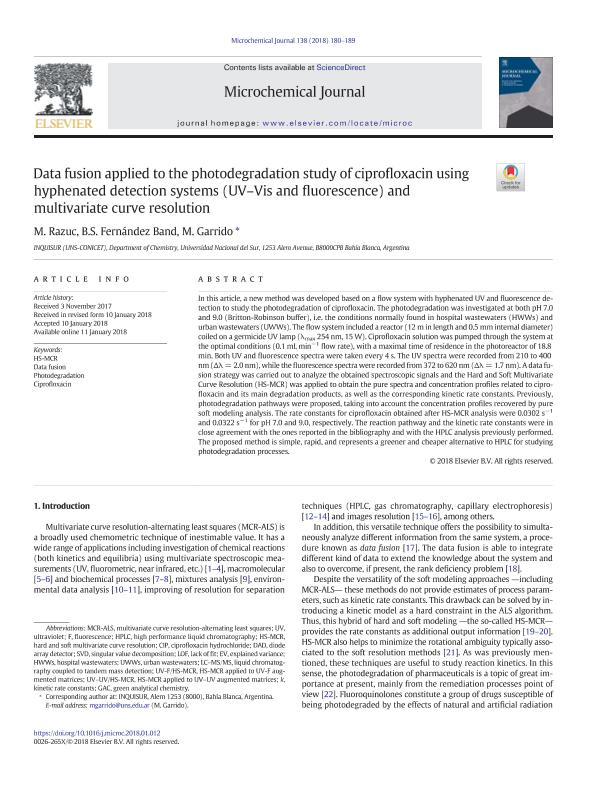Mostrar el registro sencillo del ítem
dc.contributor.author
Razuc, Mariela Fernanda

dc.contributor.author
Fernández Band, Beatriz Susana

dc.contributor.author
Garrido, Mariano Enrique

dc.date.available
2019-12-04T16:06:06Z
dc.date.issued
2018-05
dc.identifier.citation
Razuc, Mariela Fernanda; Fernández Band, Beatriz Susana; Garrido, Mariano Enrique; Data fusion applied to the photodegradation study of ciprofloxacin using hyphenated detection systems (UV–Vis and fluorescence) and multivariate curve resolution; Elsevier Science; Microchemical Journal; 138; 5-2018; 180-189
dc.identifier.issn
0026-265X
dc.identifier.uri
http://hdl.handle.net/11336/91351
dc.description.abstract
In this article, a new method was developed based on a flow system with hyphenated UV and fluorescence detection to study the photodegradation of ciprofloxacin. The photodegradation was investigated at both pH 7.0 and 9.0 (Britton-Robinson buffer), i.e. the conditions normally found in hospital wastewaters (HWWs) and urban wastewaters (UWWs). The flow system included a reactor (12 m in length and 0.5 mm internal diameter) coiled on a germicide UV lamp (λmax 254 nm, 15 W). Ciprofloxacin solution was pumped through the system at the optimal conditions (0.1 mL min−1 flow rate), with a maximal time of residence in the photoreactor of 18.8 min. Both UV and fluorescence spectra were taken every 4 s. The UV spectra were recorded from 210 to 400 nm (Δλ = 2.0 nm), while the fluorescence spectra were recorded from 372 to 620 nm (Δλ = 1.7 nm). A data fusion strategy was carried out to analyze the obtained spectroscopic signals and the Hard and Soft Multivariate Curve Resolution (HS-MCR) was applied to obtain the pure spectra and concentration profiles related to ciprofloxacin and its main degradation products, as well as the corresponding kinetic rate constants. Previously, photodegradation pathways were proposed, taking into account the concentration profiles recovered by pure soft modeling analysis. The rate constants for ciprofloxacin obtained after HS-MCR analysis were 0.0302 s−1 and 0.0322 s−1 for pH 7.0 and 9.0, respectively. The reaction pathway and the kinetic rate constants were in close agreement with the ones reported in the bibliography and with the HPLC analysis previously performed. The proposed method is simple, rapid, and represents a greener and cheaper alternative to HPLC for studying photodegradation processes.
dc.format
application/pdf
dc.language.iso
eng
dc.publisher
Elsevier Science

dc.rights
info:eu-repo/semantics/openAccess
dc.rights.uri
https://creativecommons.org/licenses/by-nc-sa/2.5/ar/
dc.subject
CIPROFLOXACIN
dc.subject
DATA FUSION
dc.subject
HS-MCR
dc.subject
PHOTODEGRADATION
dc.subject.classification
Química Analítica

dc.subject.classification
Ciencias Químicas

dc.subject.classification
CIENCIAS NATURALES Y EXACTAS

dc.title
Data fusion applied to the photodegradation study of ciprofloxacin using hyphenated detection systems (UV–Vis and fluorescence) and multivariate curve resolution
dc.type
info:eu-repo/semantics/article
dc.type
info:ar-repo/semantics/artículo
dc.type
info:eu-repo/semantics/publishedVersion
dc.date.updated
2019-10-21T20:18:29Z
dc.journal.volume
138
dc.journal.pagination
180-189
dc.journal.pais
Países Bajos

dc.journal.ciudad
Amsterdam
dc.description.fil
Fil: Razuc, Mariela Fernanda. Consejo Nacional de Investigaciones Científicas y Técnicas. Centro Científico Tecnológico Conicet - Bahía Blanca. Instituto de Química del Sur. Universidad Nacional del Sur. Departamento de Química. Instituto de Química del Sur; Argentina
dc.description.fil
Fil: Fernández Band, Beatriz Susana. Consejo Nacional de Investigaciones Científicas y Técnicas. Centro Científico Tecnológico Conicet - Bahía Blanca. Instituto de Química del Sur. Universidad Nacional del Sur. Departamento de Química. Instituto de Química del Sur; Argentina
dc.description.fil
Fil: Garrido, Mariano Enrique. Consejo Nacional de Investigaciones Científicas y Técnicas. Centro Científico Tecnológico Conicet - Bahía Blanca. Instituto de Química del Sur. Universidad Nacional del Sur. Departamento de Química. Instituto de Química del Sur; Argentina
dc.journal.title
Microchemical Journal

dc.relation.alternativeid
info:eu-repo/semantics/altIdentifier/url/https://www.sciencedirect.com/science/article/pii/S0026265X17311001
dc.relation.alternativeid
info:eu-repo/semantics/altIdentifier/doi/http://dx.doi.org/10.1016/j.microc.2018.01.012
Archivos asociados
